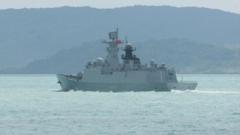Recent military exercises by China in the Tasman Sea, involving three naval ships, have led to the diversion of flights between Australia and New Zealand. This unusual activity has drawn attention and prompted significant air traffic adjustments. Australian airline Qantas announced that it “temporarily adjusted” flight routes, with other carriers reportedly doing the same in response to the fleet's proximity and potential live-fire drills.
These drills, taking place in international waters, have raised concerns among both Australia and New Zealand. As of now, the Chinese naval group, which consists of a frigate, a cruiser, and a supply tanker, is located approximately 340 nautical miles off the New South Wales coast, having come as close as 150 nautical miles east of Sydney at times. Australian authorities are on alert and have dispatched their own vessels to keep an eye on the situation.
New Zealand's Defence Minister Judith Collins expressed discontent, stating that China had not informed her country about the military maneuvers. "They have not deigned to advise us on what they are doing in the Tasman Sea," she commented, underlining the lack of communication. In contrast, Australian Defence Minister Richard Marles characterized the situation as “unusual” yet not unprecedented in the region.
In a statement, China's foreign ministry confirmed the naval training and exercises were conducted safely, adhering to international law. Spokesman Guo Jiakun emphasized that the operations were executed professionally and within legal parameters. Australian Prime Minister Anthony Albanese also addressed the situation, noting that although the exercises might involve live fire, they do not pose an immediate threat to assets from either nation.
However, Marles highlighted a lack of direct notification from China regarding the drills. "What China did was put out a notification that it was intending to engage in live fire" that went unnoticed by the Australian government until it was broadcasted to commercial airlines in the area. This lack of advanced notice has raised safety concerns for many in the aviation sector, as exemplified by an Emirates flight being informed of the military action while in transit.
Qantas reiterated its commitment to ensuring safe air travel by continuously monitoring airspace in light of the drills. Virgin Australia and Air New Zealand also adjusted their operations to navigate the evolving situation.
The drills come shortly after a dialogue on military transparency and communication between Australian and Chinese defense officials, hinting at a complex relationship as maritime encounters continue to escalate. Earlier this month, a Chinese fighter jet came dangerously close to an Australian military aircraft during an encounter in the South China Sea, an incident indicative of the rising tensions between the two nations.
While these drills and the resultant shifts in air traffic underscore the escalating military maneuvering in the region, they also bring to the forefront the need for improved communication and transparency between Australia, New Zealand, and China as relations evolve in this strategically vital maritime area.


















